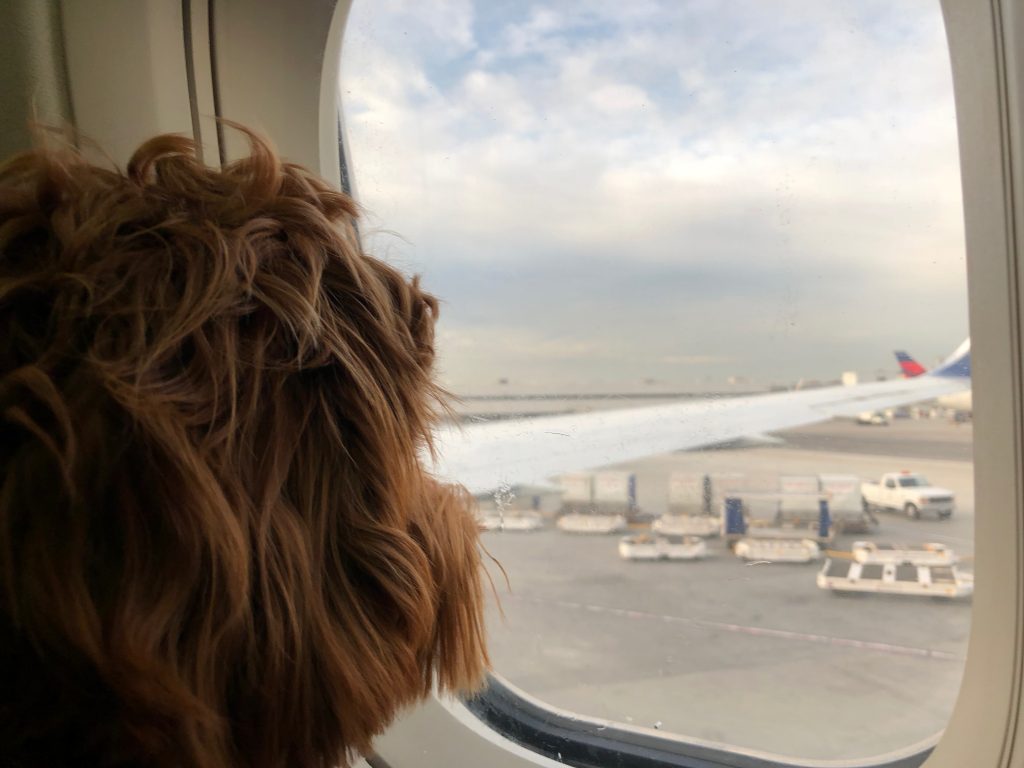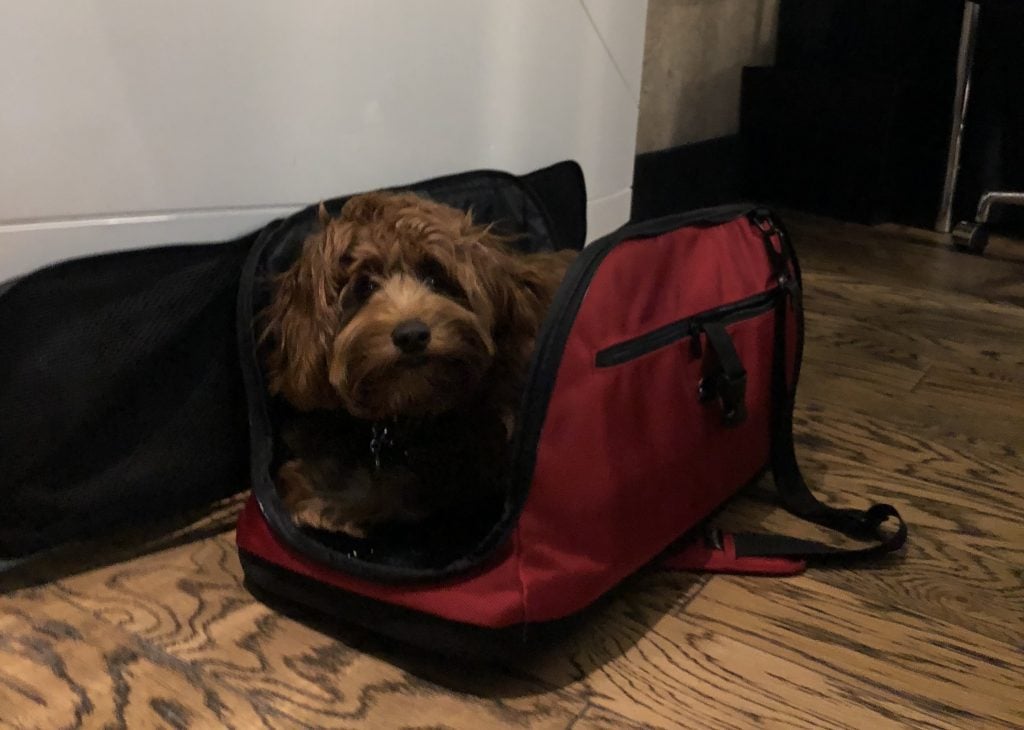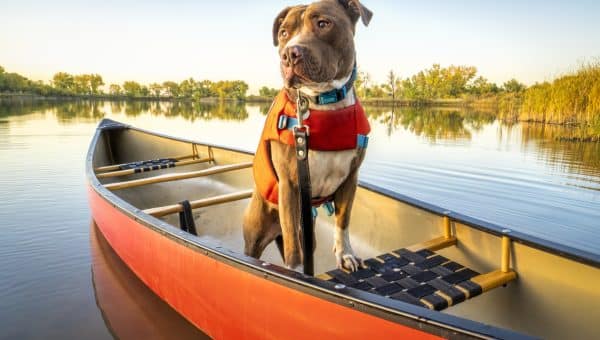- This post contains affiliate links. Read more here.
As a dog lover, it was hard not to feel heartbroken when the news came out about the 10-month old French bulldog puppy who passed away after the owner was forced to put the dog in the overhead compartment by United flight attendants. Sadly, that wasn’t the only recent fatal incident for pets in the air—24 pets died on airplanes last year. These incidents reignite the question: Is it safe to travel with your beloved dog on a plane at all?
Is it safe to take dogs on airplanes?
There are several opinions on the topic. The American Society for the Prevention of Cruelty to Animals (ASPCA) discourages air travel with large dogs that would need to go in cargo, even if it’s on a pet-friendly airline. “Unless your furry friend is small enough to ride under your seat, it’s best to avoid air travel with your pets,” they advise.
Nicole Ellis, a Certified Professional Dog Trainer in Los Angeles who travels frequently with her smaller dogs in-cabin, agrees. “I certainly don’t recommend it to my clients and I wouldn’t ever put my dog underneath in cargo,” she said.
If you must bring your dog and he can only travel in cargo, the ASPCA recommends that you book a direct flight, get a checkup with the vet and let them know of your plans to travel. They do not recommend sedation for a pet, as it may affect their breathing.
“We don’t sedate pets when they’re going in cargo, because there’s nobody to observe them,” agreed Dr. Patrick Mahaney, a Los Angeles veterinarian and Certified Veterinary Acupuncturist. This is especially important for short-nosed (brachycephalic) dogs. “They’re at much higher risk for exhaust [and] heat-related issues, because they can’t ventilate as well because of their squish nose and otherwise altered respiratory tract. It’s a much higher likely set of illness and death,” he said.
However, Dr. Mahaney did consider sedatives an option for especially anxious pets who are in-cabin. “Sedatives are something I recommend people speak to their veterinarians [about] to figure out what’s going to be the most appropriate for their pet.” He also recommends owners test the sedatives in advance of the trip so that they know how the drugs affect their pet and whether the dosage is accurate.
The American Veterinary Medical Association (AVMA) doesn’t outright discourage cargo compartment travel, but does echo the ASPCA’s suggestions on labeling the crate, and they also discourage tranquilization.
- Photo © Nicole Ellis
Considerations before dog airline travel
Is your pet healthy enough for travel?
Senior pets, or pets with cardiac or endocrine issues, can be at higher risk during plane travel. “Be concerned about these animals that have diseases that could compromise their safety while they fly,” Dr. Mahaney said. Talk with your veterinarian about any concerns you or they have about your pet’s ability to fly.
Does your pet have the right temperament to fly?
Even if your pet is physically well, that doesn’t mean that flying is a good choice. Air travel can be stressful for pets, and making sure they have a temperament that works well with change is important. “On an airline, we have lots of weird sounds. The altitude changes, the pressure changes, their ears pop and it’s loud, and their ears are a lot more sensitive than ours,” Ellis described. “Something to think about: is your pet relaxed in new environments?”
“We want a dog that is generally pleasant and ideally calm,” Dr. Mahaney said. “A calm, pleasant dog that does well in closed environments with other people and possibly other dogs.”
Will your pet have a good time where you’re headed?
“Are you bringing your pet somewhere that’s going to have a lot of pet-friendly things that your pet can enjoy? Because if not, the stress of traveling is probably not worth it for them,” Ellis suggested. “If you’re going to be on a boat and sightseeing museums, those aren’t really pet-friendly things and your pet might enjoy being home with a pet sitter instead of partaking in those.”
Services like Rover’s pet and house sitting options would let your pet stay in the comfort of their own home with a new friend to play with while you’re out jet-setting, so both of you can have a good time. Or, if there are days where your pet won’t be welcome on your travels, Rover likely operates in your destination city. There, you can have a sitter you trust to watch your dog while you go on an excursion.
- Photo © Nicole Ellis
Tips for taking a dog on a plane
If you’ve decided flying with your pet is the right option, here are some tips our experts recommended for traveling.
1. Check your airline’s rules and regulations
Airlines have different rules when it comes to breeds they allow on flights, how much advance notice they require, what size of pet carrier you’ll need, etc. Be sure you’ve read up on your airline’s pet requirements well in advance of your trip.
2. Prepare the right crate
Generally, in-cabin crates should be soft-sided and fit under the plane seat in front of you. Ellis recommends SleepyPod carriers for small in-cabin pets.
For cargo crates, the ASPCA says that crates should be large enough for your pet to sit, stand and turn around in. The crate door should be closed securely but not locked. Labeling is crucial. Mark the crate with a large, bold “Live Animal” warning on the outside with a photo of your pet. You’ll want to line the floor with towels to absorb any accidents, and tape a small amount of food to the outside of the carrier so airline employees can feed your pet if necessary. You may also consider freezing a small tray of water, which should stay frozen while loading your pet but may melt by the time they’re thirsty.
Consider writing your name, cell phone number, and destination phone number on the crate, in case it’s misplaced by the airline. They also recommend alerting every airline employee you see, both at the airport and when you’re in the air, that you have a pet in cargo, and requesting wellness checks when you have concerns.
Check out our top 13 dog travel crates for more guidance. We also have a video review of the Sleepypod AIR so you can see that travel carrier in action:
3. Get your pet comfortable with their carrier
Don’t expect your pet to immediately love their carrier. Provide ample time before the trip to introduce it to them and make it a place they like. “Lure them in and give them lots of treats and toys and pets and positive things while they’re in that carrier and you’re home,” Ellis suggested. “You can practice walking around the block with your carrier, taking it out to breakfast with you and sitting on the patio, and just making it this nice, comfortable and safe area for your animal.”
4. Exhaust your pet two days in advance
In the days leading up to your trip, try lengthening your walks or runs together. “Try to increase the level of activity for 48 hours beforehand, so that when your pet needs to be in cabin or in cargo they’ll be more prone to not being stressed out, instead resting or sleeping,” Dr. Mahaney advised.
5. Restrict food in advance of the flight and go for a long walk the morning of
For 12–24 hours before your flight, give your pet less access to food. “Then your pet is going to be less likely to poop,” Dr. Mahaney advises. Additionally, take your pet for a long walk before your flight so they have plenty of opportunities to relieve themselves.
6. Bring vaccination records and microchip numbers
Need for this paperwork can come up at the airport or at hotels, so having it handy is important. “I like to take a picture with my phone so that if I’m at a hotel or something I can usually pull it up,” Ellis suggested.
7. Get a map of your departure and arrival gates
U.S. airports are required by law to have pet-relief areas available so that working animals like K9 units or service animals have a place to rest, and your pet is welcome to use them, too. “If you look online for a map of your terminal you usually can find it, so if you know the terminal you’re taking off from and landing in, look it up,” Ellis recommended.
Most importantly, says Ellis, “You are your pet’s biggest advocate—if someone asks you to leave your pet or do something that you’re not comfortable with, say no.”
Further Reading
8 Best Travel Crates for Stress-Free Travel
Here’s Why the Top-Rated Dog Car Crates Could Save Your Dog’s Life
How to Keep Your Dog Safe in the Car (Hint: Buckle Up!)
How to Overcome Your Dog’s Car Travel Anxiety
Traveling with Your Dog: Get Expert Tips from a Professional Trainer for a Smooth Trip
Need more great pet travel suggestions? From carriers to travel bowls, see what’s new at the Rover store.
Hero image © Nicole Ellis.






